
The Grumman C-2 Greyhound is a twin-engine, high-wing cargo aircraft designed to carry supplies, mail, and passengers to and from aircraft carriers of the United States Navy. Its primary mission is carrier onboard delivery (COD). The aircraft provides critical logistics support to carrier strike groups. The aircraft is mainly used to transport high-priority cargo such as jet engines and special stores, mail, and passengers between carriers and shore bases.

A business jet, private jet, or bizjet is a jet aircraft designed for transporting small groups of people, typically business executives and high-ranking associates. Business jets are generally designed for faster air travel and more personal comfort than commercial aircraft, and may be adapted for other roles, such as casualty evacuation or express parcel deliveries, and some are used by public bodies, government officials, VIPs, or even the military.

A regional airliner or a feeder liner is a small airliner that is designed to fly up to 100 passengers on short-haul flights, usually feeding larger carriers' airline hubs from small markets. This class of airliners is typically flown by the regional airlines that are either contracted by or subsidiaries of the larger airlines. Regional airliners are used for short trips between smaller towns or from a larger city to a smaller city. Feeder liner, commuter, and local service are all alternative terms for the same class of flight operations.

The Cessna 208 Caravan is a utility aircraft produced by Cessna. The project was commenced on November 20, 1981, and the prototype first flew on December 9, 1982. The production model was certified by the FAA in October 1984 and its Cargomaster freighter variant was developed for FedEx. The 4 ft (1.2 m) longer 208B Super Cargomaster first flew in 1986 and was developed into the passenger 208B Grand Caravan.
The FF-1080 is an aircraft design by Utilicraft Aerospace Industries of Albuquerque, New Mexico, USA, for a twin turboprop aircraft fitted to carry LD3 aircraft cargo containers between large airports and smaller airports.

The Antonov An-38 is a stretched and upgraded version of Antonov's earlier An-28. It is a twin-engined turboprop transport aircraft, designed by the Antonov Design Bureau in Kyiv, Ukraine. Production is in Novosibirsk, Russia, but some crucial parts are also made in Ukraine and Belarus. It first flew in 1994, and received international flight certification in April 2000. A total of 11 were built and 2 remain in airline service as of August 2019. A recent documentary says that only one remains in service with ALROSA Airlines in 2021.

The Antonov An-3 is a Soviet civil multipurpose and agricultural aircraft. It is essentially a turboprop-powered development of the An-2, designed to upgrade or replace it. The basic transport version (An-3T) is supplemented by a cargo/passenger version (An-3TK), an agricultural version (An-3SH), a forest fire-fighting version (An-3P), as well as an ambulance version. It is designed to carry passengers and cargo, operating from paved or unpaved airfields, including snow covered surfaces up to 35 cm (14 in) deep.

The Cessna 441 Conquest II is the first turboprop powered aircraft designed by Cessna and was meant to fill the gap between their jets and piston-engined aircraft. It was developed in November 1974, with the first aircraft delivered in September 1977. It is a pressurized, 8–9 passenger turbine development of the Cessna 404 Titan. The ICAO designator as used in flight plans is C441.

The PAC P-750 XSTOL, is a utility aircraft of conventional all-metal low-wing monoplane design, with fixed tricycle undercarriage. Combining the engine and wings of the PAC Cresco with a new larger fuselage and modified tail, all versions to date have been powered by a 750 hp (560 kW) Pratt & Whitney Canada PT6 turboprop. It is designed and manufactured in Hamilton, New Zealand, by Pacific Aerospace Limited.

The Cessna 425, known as the Corsair and later as the Conquest I, is an eight-seat American pressurized turboprop twin-engined light aircraft. Now out of production, it was built by Cessna Aircraft of Wichita, Kansas, between 1980 and 1986.

The Grumman Gulfstream I is a twin-turboprop business aircraft. It first flew on August 14, 1958.

The Xi'an MA600 is an improved version of the Xi'an MA60 manufactured by the Xi'an Aircraft Industry Corporation under the Aviation Industry Corporation of China (AVIC).
The Cessna 308 was a prototype military light transport aircraft based on the successful O-1 Bird Dog observation aircraft. Only one aircraft was completed, and the project did not proceed further due to a lack of orders.
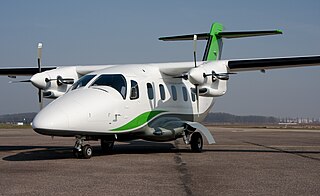
The Evektor EV-55 Outback is a twin-engine turboprop aircraft designed and built in the Czech Republic by Evektor-Aerotechnik. The prototype first flew on 24 June 2011. The project's development was suspended in March 2017.
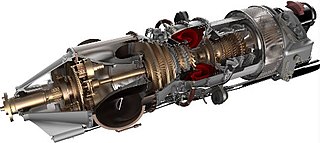
The General Electric Catalyst is a turboprop engine by GE Aerospace. It was announced on 16 November 2015 and will power the Beechcraft Denali, it first ran on December 22, 2017, and should be certified in 2024. The 850 to 1,600 hp engine aims for 20% better efficiency than its competition thanks to a 16:1 overall pressure ratio, variable stator vanes, cooled turbine blades, 3D printed parts and FADEC.
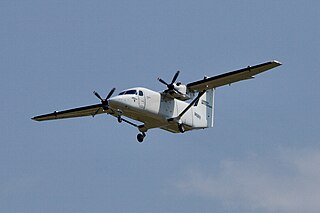
The Cessna 408 SkyCourier is an American utility aircraft designed and built by the Cessna division of Textron Aviation. It was launched on November 28, 2017, with an order for 50 from FedEx Express, with the aircraft designed for the needs of its FedEx Feeder service. It made its first flight on May 17, 2020, and was type certified on March 11, 2022. FedEx took delivery of the first production model on May 9, 2022.

The Transcend Air Vy 400 is a tiltwing convertible aircraft developed by American startup Transcend Air.
A hybrid electric aircraft is an aircraft with a hybrid electric powertrain. As the energy density of lithium-ion batteries is much lower than aviation fuel, a hybrid electric powertrain may effectively increase flight range compared to pure electric aircraft. By May 2018, there were over 30 hybrid electric aircraft projects, and short-haul hybrid-electric airliners were envisioned from 2032.
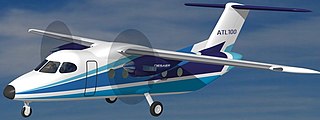
The Desaer ATL-100 is a twin-turboprop, high-wing, utility aircraft under development by Desaer in Brazil and by CEiiA in Portugal.
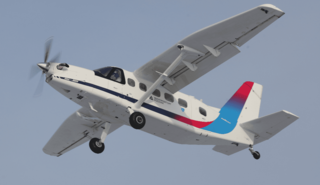
The UZGA LMS-901 Baikal is a utility aircraft produced by UZGA . The Russian Ministry of Industry and Trade selected UZGA in October 2019 to develop a replacement for the widespread Antonov An-2. The prototype made its maiden flight on 30 January 2022. The aluminum, single-turboprop airplane is powered by a GE H80 or a Klimov VK-800. It is planned to carry a 2 t (4,400 lb) payload or 9–12 passengers over 1,500 km (810 nmi) at 300 km/h (160 kn) from short unpaved airstrips.

















